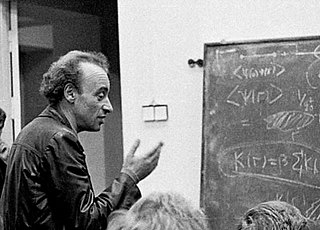
Lev Davidovich Landau was a Soviet physicist who made fundamental contributions to many areas of theoretical physics. He was considered as one of the last scientists who were universally well-versed and made seminal contributions to all branches of physics.

Vitaly Lazarevich Ginzburg, ForMemRS was a Russian physicist who was honored with the Nobel Prize in Physics in 2003, together with Alexei Abrikosov and Anthony Leggett for their "pioneering contributions to the theory of superconductors and superfluids."

The Institute for Theoretical and Experimental Physics is a multi-disciplinary research center located in Moscow, Russia. ITEP carries out research in the fields of theoretical and mathematical physics, astrophysics, high energy particle physics, nuclear physics, plasma physics, solid state physics, nanotechnology, reactor and accelerator physics, medical physics, and computer science. ITEP also maintains an extensive educational program and organizes physics schools for scholars and undergraduates. The institute is located near the corner of the Sevastopol prospect and the Nachimowski prospect and occupies part of the former estate "Cheryomushki-Znamenskoye" – an 18th-century manor that is a monument of architecture and landscape art of the 18th–19th centuries.

Moscow Institute of Physics and Technology, is a public research university located in Moscow Oblast, Russia. It prepares specialists in theoretical and applied physics, applied mathematics and related disciplines.

Alexander Markovich Polyakov is a Russian theoretical physicist, formerly at the Landau Institute in Moscow and, since 1989, at Princeton University, where he is the Joseph Henry Professor of Physics Emeritus.

Isaak Markovich Khalatnikov was a leading Soviet theoretical physicist who made significant contributions to many areas of theoretical physics, including general relativity, quantum field theory, as well as the theory of quantum liquids. He is well known for his role in developing the Landau-Khalatnikov theory of superfluidity and the so-called BKL conjecture in the general theory of relativity.
Isaak Yakovlevich Pomeranchuk was a Soviet physicist of Polish origin in the former Soviet nuclear weapons program. His career in physics spent mostly studying the particle physics, quantum field theory, electromagnetic and synchrotron radiation, condensed matter physics and the physics of liquid helium.
Arkady Beynusovich (Benediktovich) Migdal was a Soviet physicist and member of the Academy of Sciences of the Soviet Union. He developed the formula that accounts for the Landau–Pomeranchuk–Migdal effect, a reduction of the bremsstrahlung and pair production cross sections at high energies or high matter densities.

Vladimir Naumovich Gribov was a prominent Russian theoretical physicist, who worked on high-energy physics, quantum field theory and the Regge theory of the strong interactions.
The Pomeranchuk Prize is an international award for theoretical physics, awarded annually since 1998 by the Institute for Theoretical and Experimental Physics (ITEP) from Moscow. It is named after Russian physicist Isaak Yakovlevich Pomeranchuk, who together with Landau established the Theoretical Physics Department of the Institute.
Alexander Zakharovich Patashinski was a Soviet and Russian physicist. He is a professor for Materials Research Scientist and professor at Northwestern University in Evanston, Illinois.
The Kharkiv Theoretical Physics School was founded by Lev Landau in Kharkov, Soviet Union and further developed by Oleksandr Akhiezer and Ilya Lifshitz, following Landau's flight to the Kapitza’s Institute for Physical Problems in Moscow in 1937 in an attempt to avoid an arrest during the UPTI Affair.

Karen Avetovich Ter-Martirosyan was a Soviet and Russian theoretical physicist of Armenian descent. He is known for his contributions to quantum mechanics and quantum field theory and the author of several hundred articles in his area.
Vadim L'vovich Berezinskii was a Soviet physicist. He was born in Kyiv, graduated from Moscow State University in 1959, and worked in Moscow and the Landau Institute for Theoretical Physics. He is famous for having identified the role played by topological defects in the low-temperature phase of two-dimensional systems with a continuous symmetry. His work led to the discovery of the Berezinskii–Kosterlitz–Thouless transition, for which John M. Kosterlitz and David J. Thouless were awarded the Nobel Prize in 2016. He also developed a technique for treating electrons in one-dimensional disordered systems and provided first consistent proof of one-dimensional localization, and predicted negative-gap superconductivity.

The Landau Gold Medal is the highest award in theoretical physics awarded by the Russian Academy of Sciences and its predecessor the Soviet Academy of Sciences. It was established in 1971 and is named after Soviet physicist and Nobel Laureate Lev Landau. When awarded by the Soviet Academy of Sciences the award was the "Landau Prize"; the name was changed to the "Landau Gold Medal" in 1992.
Vladimir Petrovich Mineev is a Russian theoretical physicist, specializing in condensed matter physics.








